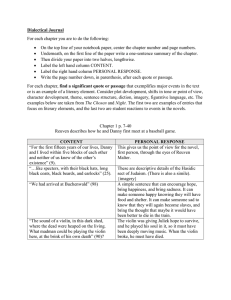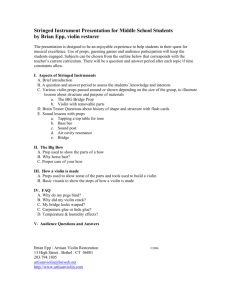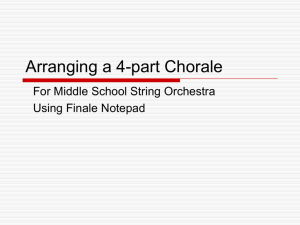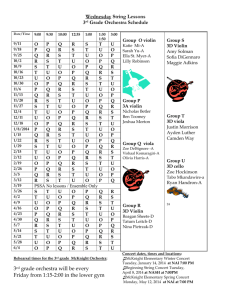IX. PROCESS ANALYSIS AND SYNTHESIS E.
advertisement
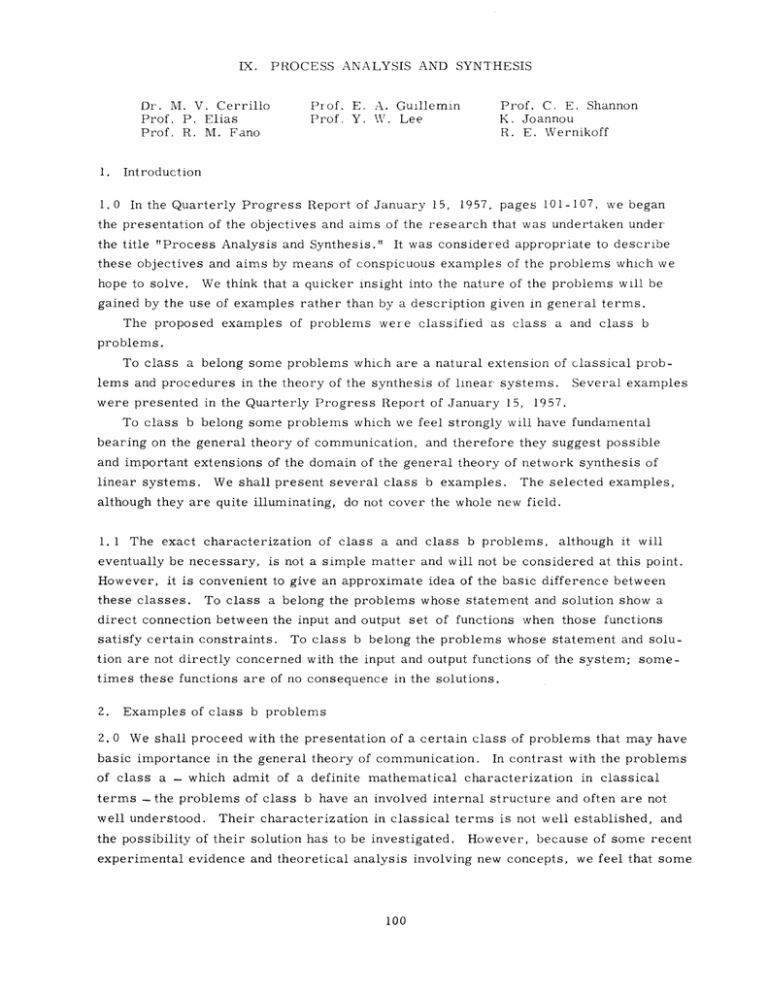
IX. PROCESS ANALYSIS AND SYNTHESIS Dr. M. V. Cerrillo Prof. P. Elias Prof. R. M. Fano 1. 1.0 Prof. E. A. Guillemin Prof, Y. WV. Lee Prof. C. E. Shannon K. Joannou R. E. Wernikoff Introduction In the Quarterly Progress Report of January 15, 1957, pages 101-107, we began the presentation of the objectives and aims of the research that was undertaken under the title "Process Analysis and Synthesis." It was considered appropriate to describe these objectives and aims by means of conspicuous examples of the problems which we hope to solve. We think that a quicker insight into the nature of the problems will be gained by the use of examples rather than by a description given in general terms. The proposed examples of problems were classified as class a and class b problems. To class a belong some problems which are a natural extension of classical problems and procedures in the theory of the synthesis of linear systems. were presented in the Quarterly Progress Report of January 15, Several examples 1957. To class b belong some problems which we feel strongly will have fundamental bearing on the general theory of communication, and therefore they suggest possible and important extensions of the domain of the general theory of network synthesis of linear systems. We shall present several class b examples. although they are quite illuminating, The selected examples, do not cover the whole new field. 1. 1 The exact characterization of class a and class b problems, although it will eventually be necessary, is not a simple matter and will not be considered at this point. However, it is convenient to give an approximate idea of the basic difference between these classes. To class a belong the problems whose statement and solution show a direct connection between the input and output set of functions when those functions satisfy certain constraints. To class b belong the problems whose statement and solu- tion are not directly concerned with the input and output functions of the system; sometimes these functions are of no consequence in the solutions. 2. Examples of class b problems 2. 0 We shall proceed with the presentation of a certain class of problems that may have basic importance in the general theory of communication. of class a - In contrast with the problems which admit of a definite mathematical characterization in classical terms - the problems of class b have an involved internal structure and often are not well understood. Their characterization in classical terms is not well established, the possibility of their solution has to be investigated. However, because of some recent experimental evidence and theoretical analysis involving new concepts, 100 and we feel that some (IX. PROCESS ANALYSIS AND SYNTHESIS) of the class b problems may have rather simple internal structures and may admit of straightforward mathematical characterization. 2. 1 A simple inspection of these problems immediately suggests their importance when we consider their implications, their solutions, and their applications. These problems are not mathematically characterized by transformation between input and output functions, but they describe functional processes of system behavior in which the system input and output functions are indirectly connected with the problems, or are of no consequence in their solution. Because of the functional processes involved in class b problems, we adopted the name of this new project. The objective of the project is to study the possibility of solving such problems. 2. 2 As an appropriate illustration, we have selected a few particular examples. The problems presented pertain to a specific field, and we have to introduce names, actors, and situations, in order to grasp the nature of the problems that we have in mind. Thus we talk about music and musicians. To appreciate the important significance of some of these, and similar, problems in the general theory of communication, we have to judge these examples by their implications rather than by the local and particular situation described in the few examples that are given. We must point out again that the selected examples do not cover the whole field of our research; they are given for the purpose of describing the nature of some new extensions. I. The Problem of Rhythm Extraction Let us consider music in elementary terms. elements of music. Rhythm is one of the basic structural It is a sort of recurrent discrete framework that governs the time distribution of intervals of sound and silence. This distribution is independent of the frequency of the musical notes that constitute the sounds. The other basic elements of music - melody and harmony - are supported by this rhythmic framework. quantitative and qualitative elements. Rhythm has The quantitative elements are formed by the num- ber of sound and silence intervals which, as a group, have a cyclical recurrence. The qualitative elements are formed by the emphasis, or accent, placed on certain musical notes that occur at periodic points in this structural framework. Now, if with the quan- titative and qualitative elements of the rhythm we associate a certain time duration to every elementary interval of the framework in such a way that every cyclic group of the rhythm has the same time duration, then we say that a meter has been introduced. The meter in a musical composition need not be the same during all of its different parts. It can change from part to part and may be repeated. It may also happen that different harmonic groups follow different but congruent rhythms. occur. Syncopation may also For simplicity in the presentation of the following problem, we shall consider 101 PROCESS ANALYSIS AND SYNTHESIS) (IX. only musical compositions that have the same meter all the way through. The rhythm of a musical composition can be isolated when the music is heard. This isolation can be accomplished with more or less ease, depending upon the kind of music and the training of the listener. In most popular music, for example, be quickly isolated after listening to a few beats of the meter. the rhythm can That is why almost any- body can dance - or at least we think we can. Now to our problem: "Construct a system with two-pair access terminals such that, when excited by an input function taken from an appropriate recording of a musical composition, having, for example, constant meter throughout, then the output function of the system repro- duces the rhythm elements of the composition as tapped sounds, or as a recorded graph, or as a sampling of the beat on an oscilloscope screen. This separation of the rhythm has to be made just after the first few beats of the meter have occurred and it must be made independently of the tempo in which the music is written." This problem implies the separation of the very low frequency components of the envelope wave, and the separation must be made in a time of the same order of magnitude as the period of these low-frequency periodicities. constructed in the Laboratory. Such a system has already been A further discussion of the problem and description of the system design will be given in subsequent Quarterly Progress Reports. II. The Problem of the Walking Musicians Suppose that a musical band is playing a march. still in a large, open town square. The band is assumed to be standing Now, a regular one-track recording of such a march is made with all of the microphones standing at rest and close to the band. Let us consider some interesting situations which will describe some effects that we want to reproduce. Effect A. First: Let us suppose that a person - we shall refer to him as the listener - situated far away from the band; for example, on the opposite side of the square. is He will hear the music as the distinct and characteristic sound of music that is played from a distance. Second: Let us now assume that the band starts moving at a specific walking speed toward the listener. He will hear the music as the characteristic approaching the listener, as in a parade; sound of a band soon afterward he will hear the typical sound produced by a band when it is in his immediate vicinity; and finally he will hear the typical sound of a band that is moving away from him. In all of this process of motion the average experienced listener can judge or, rather, make a fair estimate of the distance of the band just by listening to the distinctive sound of the music. 102 (IX. PROCESS ANALYSIS AND SYNTHESIS) Now, our objective is to imitate effect A as follows: "Construct a finite linear system - it may contain time-variable elements - that has two sets of access terminals such that, when excited in one terminal pair by the corresponding signal produced by the recording mentioned above (band and microphones together and stationary), then a loud-speaker connected to the other terminal pair will reproduce the music as if the band is moving as described in effect A. Effect B. An interesting but not quite (acoustically) similar effect will now be described. Suppose that the band is playing, standing still, at the end of a long corridor of given structural and acoustical dimensions. A recording is made with microphones that are stationary and close to the band. First: Let us assume that the listener is placed at the far end of the long corridor. He will hear the music as the distinct sound of music that is played at a distance, but it is different from the way it sounds in an open square. Second: Let us fix the listener's position and now make the music move at a definite walking speed toward him, pass in front of him, and then move away from him. Now we want to construct, as before, a linear time-variable element and finite linear system which imitates this marching effect of the music in the corridor when we excite the system by a recording of the stationary band and stationary microphones placed in the immediate vicinity of the band. This example illustrates clearly the nature of this "process problem," especially if we consider that the "walking effect" of the musicians has nothing to do with the particular composition that is played by the band. A discussion of this problem and proposed solutions will be presented in the continuation of these notes in subsequent Quarterly Progress Reports. III. The Problem of the Violinist, the Experts, and the Savage Before precisely stating the problem it is convenient to make some preparatory remarks. Let us assume that a violinist is playing a tune inside a room. We assume that this musician is a violinist of average ability and that he plays an "average" violin. What tune he plays does not matter. A second person, who had no previous knowledge that a violin was being played, enters the room. Whether or not he sees the actual instrument, violinist, the violinmaker, and independent of the and of the particular moment at which he enters the room, it takes just a few seconds for him to realize and to be sure that a violin is being played. Moreover, his certainty has a remarkable degree of accuracy whose evaluation is far beyond the power of the probability calculus. The second person will certainly be amazed if he happens to realize the remarkable ease with which he recognizes the playing of the violin. 103 Let us assume that he asks (IX. PROCESS ANALYSIS AND SYNTHESIS) himself the question, "Why is it so?" To this question he finds no straight answer, so he decides to lay the problem before some experts. The first is a physicist (or possibly an acoustical engineer) whom he may ask "What is a violin, or what characterizes a violin? " The physicist will describe the violin in terms of its frequency range, harmonic content, resonant chamber, string tension, peculiar noise, and the like. his description will be quite correct. And The physicist has had a long period of technical training; to be specific, let us say seven years, although the exact figure is irrelevant. The questioner now decides to increase the information which he has gained about violins by seeking a second expert, say a musician. He asks the musician a similar question, and he will be told about timbre, quality of sound, tonality, and so forth. This description, too, is quite correct. Another expert is then consulted, say an experienced violinmaker. The questioner will now be given a description of the violin in terms of its structural form. He will hear of dimensions, of kinds of wood and its treatment and aging, of kinds of glue, lacquer, and paint, and so on. This description is also quite correct. A fourth expert is now consulted, say an experienced statistician. Of course, for obvious reasons, this expert is going to have a hard time trying to answer his visitor's questions, but let us assume that he does his best. Assuming, now, that each expert has had at least seven years' experience in his field, we have gathered twenty-eight years of training and experience. Yet even after summing up all of these descriptions of the violin, we still do not know why we recognize a violin simply from hearing it. We might be tempted to conclude that the characterization of a violin is an extremely difficult problem. We might be right if it were not for a fifth man, who is not an expert at all and might even be a savage, because after the violin is played to him a few times he will recognize it. So it seems that we are confronted with a very confusing situation. At this point the reader may argue that the brain does the trick, and that our problem has nothing to do with previous technical training or experience. Of course, this, too, is correct. But let us consider what sort of information the brain has to start with. It has only a simple measure of the acoustic wave which acts mechanically upon the drum of the ear. From this information, the brain has to perform a certain number of operations - of which we have no idea - and after a remarkably short period of "natural training" the brain produces a precise characterization of the sound of a violin. Suppose, now, that we have recorded one, or several, musical compositions played by a violin. Then we have the same information that the brain has. Now, the experi- ment above tells us: Let f(t) be the time function representing the mere pressure of the violin music that corresponds to a certain tune. which we can scan f(t). Let AT be a definite and rather small time interval with Then 104 (IX. a. b. PROCESS ANALYSIS AND SYNTHESIS) There must be an operation on f(t) such that when applied to f(t) at any almost arbitrarily chosen interval of time A7, this operation must produce an invariant which characterizes the violin. For a given instrument (here, a violin) the invariant is almost independent of f(t), provided that all f(t) comes from the music of the same instrument (different tunes). Our problem now is to construct some class of operators that will produce on f(t) the characteristic invariant of a given instrument and have properties similar to those in a and b. Of course, the operators need not necessarily be the same as those in the brain. An abstract research along the lines discussed above is one of the fundamental tasks of this project. Some work has been done in this direction. The discussion will be continued in the Quarterly Progress Report of July 15, 1957. M. V. Cerrillo 105
